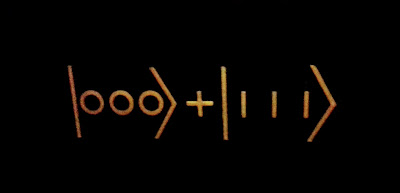Quantum Gate

It may not be entirely obvious from the photograph (which I took at night, while hashing ) but this is a wrought iron gate. It opens on to a front garden on Maid's Causeway, Cambridge. Why? I don't know. Has an important physicist lived there? There's no Blue Plaque , so maybe it's just an enthusiast, like me! What does it mean? I don't know for certain, but I suspect it is a reference to something similar to the GHSZ variant of the Bell Inequality Test . The results of this test demonstrate that there are no hidden variables in quantum mechanics. I say "similar" because, in GHSZ instead of 0 and 1 the spins $\downarrow$ and $\uparrow$ are used, and there's a minus instead of a plus. If you know anything more, please tell me!

